19 Galapagos Islands Animals [Travelers Guide] Facts, Photos, Videos…
Planning a trip to the Galapagos? Here are 19 amazing Galapagos Islands animals to watch for on your next trip! This traveler’s guide to the animals of the Galapagos will whet your appetite for adventure.
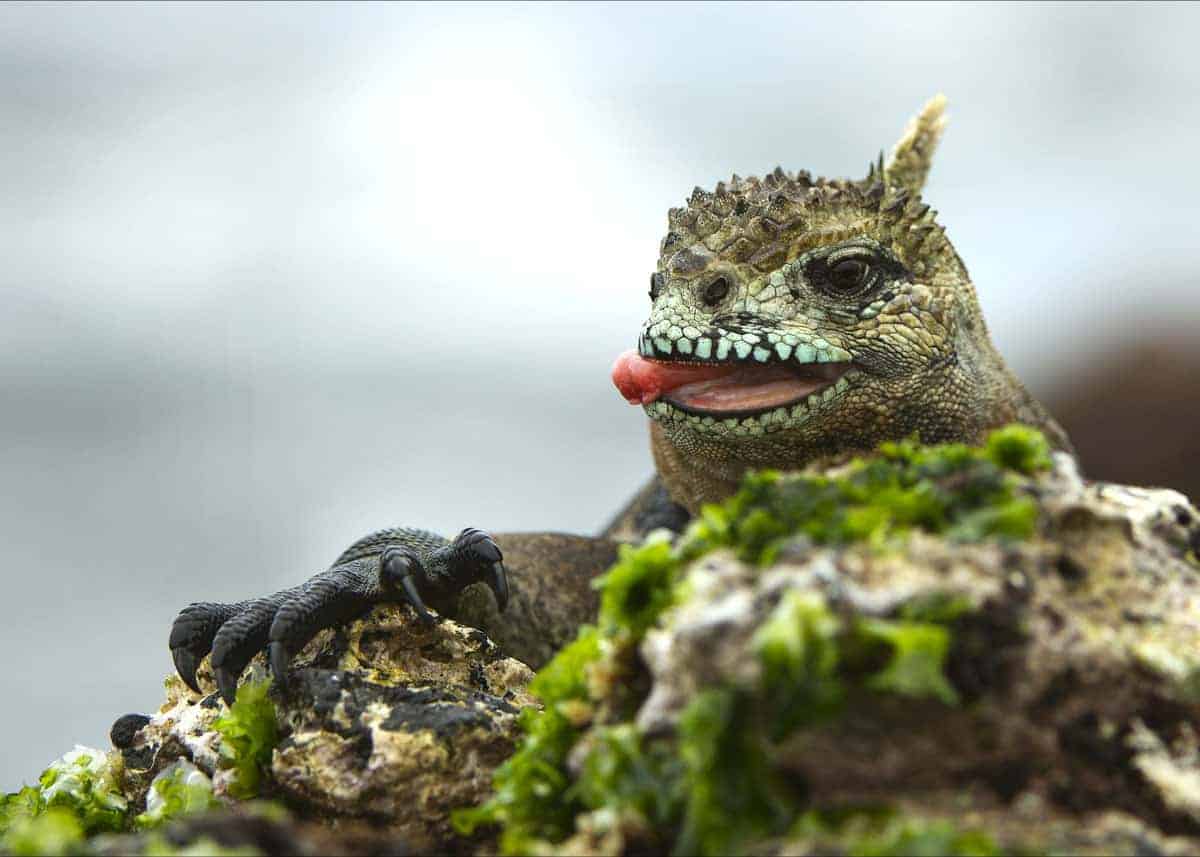
For me, one of the best things about visiting a new place is all the amazing animals I get to see along the way.
When I visited the Galapagos, I was in heaven! These islands have so many amazing animals – here are some of the animals you might see on your trip:
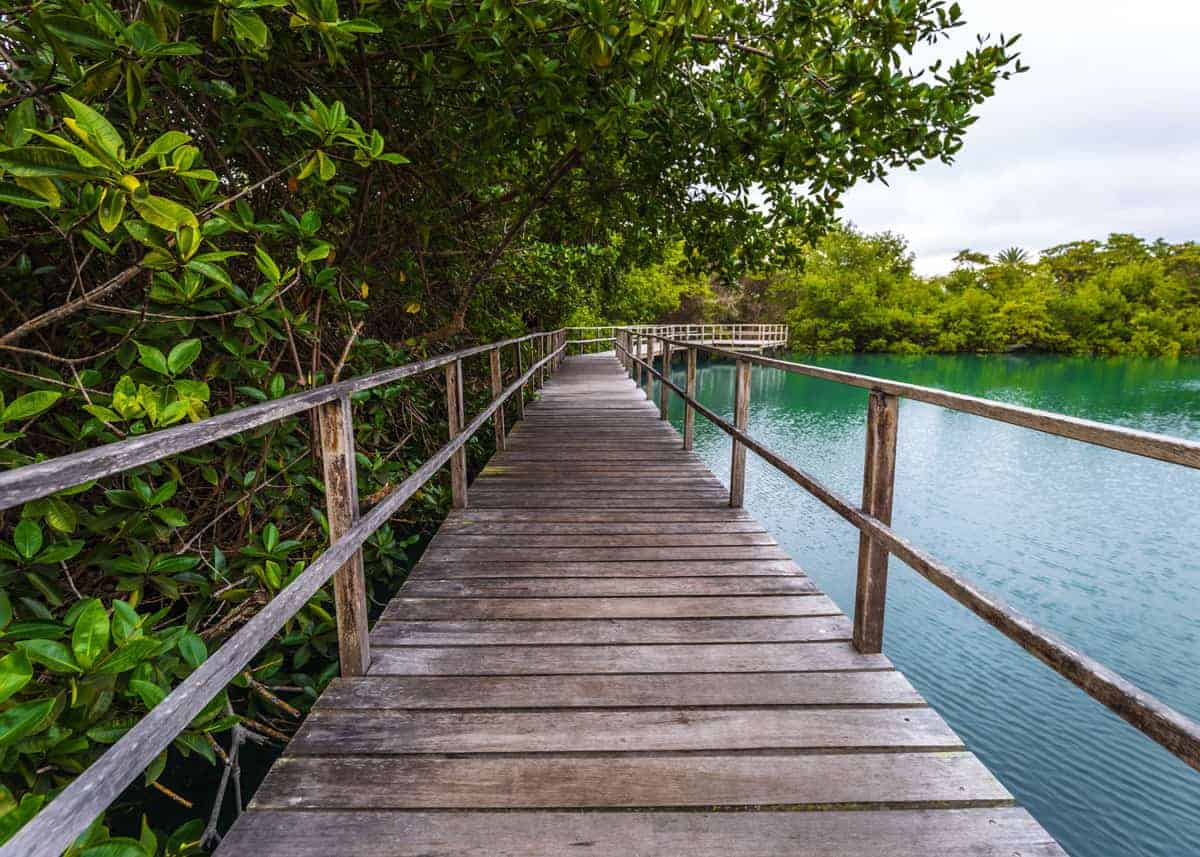
19 Galapagos Islands Animals You Need to See
The Galapagos Islands are an amazing place to see fascinating animals, they are everywhere!
You can see so many of them right outside your hotel room or in town – which is one of the things that makes the Galapagos so special: the almost seamless blending of everyday life and wild animals. It would be extremely rare to go to the Galapagos and not see most of these animals!
Traveler Tip: Learn more about each animal in our list by visiting the post linked at the bottom of each section.
Remember: National Park Rules require that visitors maintain a distance of 6 ft (2 m) from animals at all times and never feed the animals. This is for the animal’s protection and yours! Help keep the Galapagos tourist-friendly by following these 14 simple rules.
1. Galapagos Sea Lion (zalophus wollebaeki)
The Galapagos sea lion is a personal favorite of mine, they are just so sweet-looking!
However, they are called sea lions, so don’t be fooled by that sweet face. While these animals are generally quite peaceful and unafraid of people, males can become aggressive in the mating season because they are very territorial.
They are very large animals, so if you angered one… well, just don’t anger one. Galapagos sea lions average 59-98 in (150-250 cm) in length and 110-880 lb (50-400 kg) in weight.
As long as you listen to your guide (you should always go on guided tours – they know the Galapagos way better than any of us!) you shouldn’t have any problems. I even got to go swimming with a young male sea lion – and that was amazing!
Here’s what it was like:
Galapagos sea lions eat up to 45 lb (20 kg) of food daily – 70% of which is sardines. They are deep divers, able to reach up to (down to?) 196 ft (60 m), and they can hold their breath for up to 20 minutes.
2. Sally Lightfoot Crabs – a.k.a Red Rock Crab (Grapsus grapsus)
Sally lightfoot crabs are famous for their bright colors and, of course, their fancy footwork. These spunky little fellows are up to 5 in (12 cm) across their carapace, and the internet has yet to know how much they weigh but 1/2 lb is a reasonable estimate.
Their name is thought to have come from a Caribbean dancer, but no one really knows for sure. Regardless, it suits them.
It’s hard to imagine these bright crabs as being anything but bright, however, they start their lives out as tiny, black, and white/yellow-spotted crabs that blend into lava rocks so much that it’s hard to spot them. As they grow up they get brighter colors.
These little rainbows can run so fast that they can even seem to run on water. They can jump and skip across the water for short distances (I remember about 3 ft) to get away from predators – or pesky sunburned tourists. After the short distance, they start to swim-run; a very entertaining spectacle indeed!
Learn more about Sally Lightfoot crabs in our huge guide.
A favorite pastime for Sally lightfoot crabs is sitting on marine iguanas and eating skin parasites, joy! Their relationship is symbiotic.
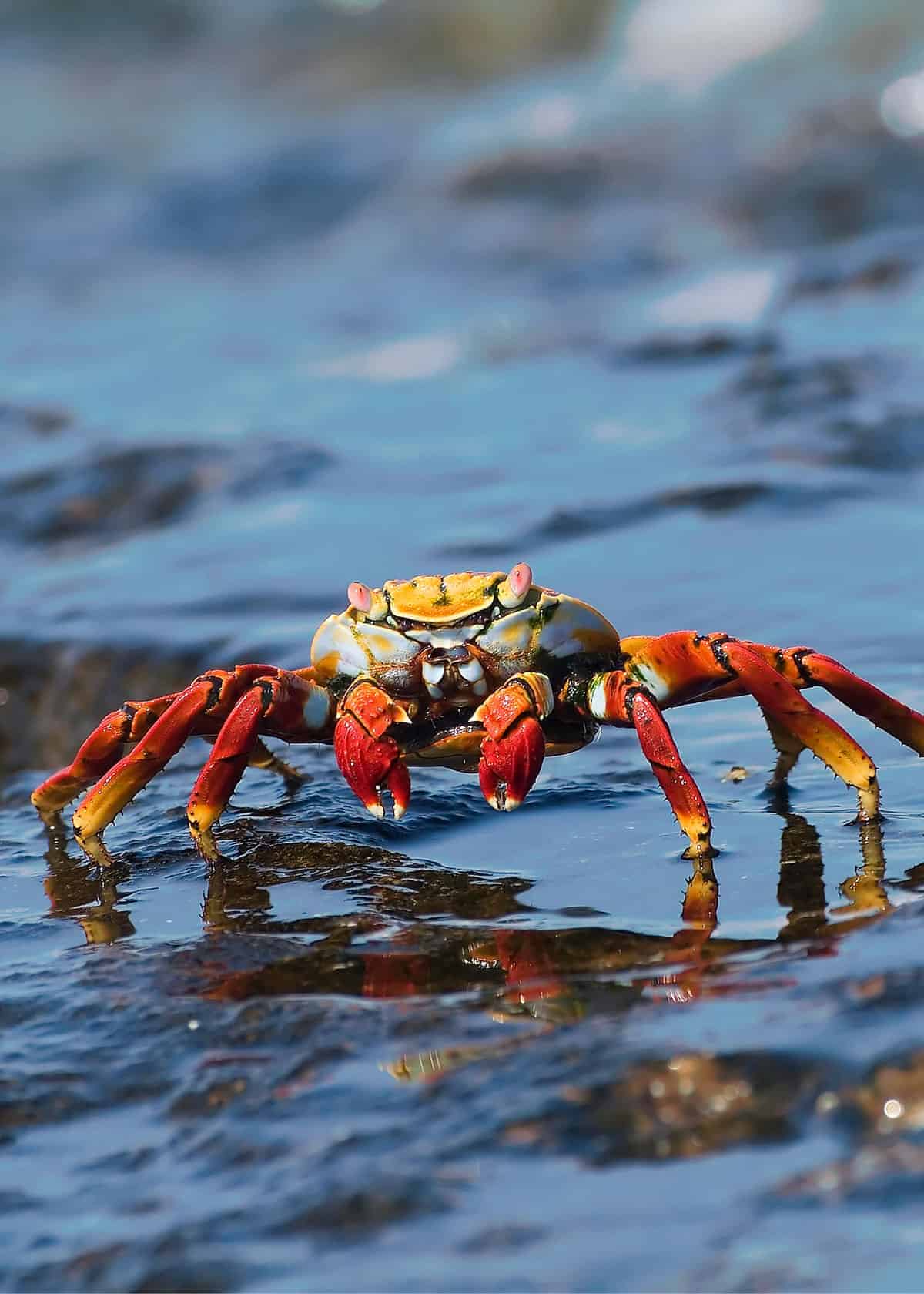
3. Lava Lizards (microlophus albemarlensis)
Lava lizards are all over the place in Galapagos. Their name suits them well – the best place to see them is skittering over the black lava rocks that cover the islands.
In fact, their colors can change depending on what island they live on – and their mood.
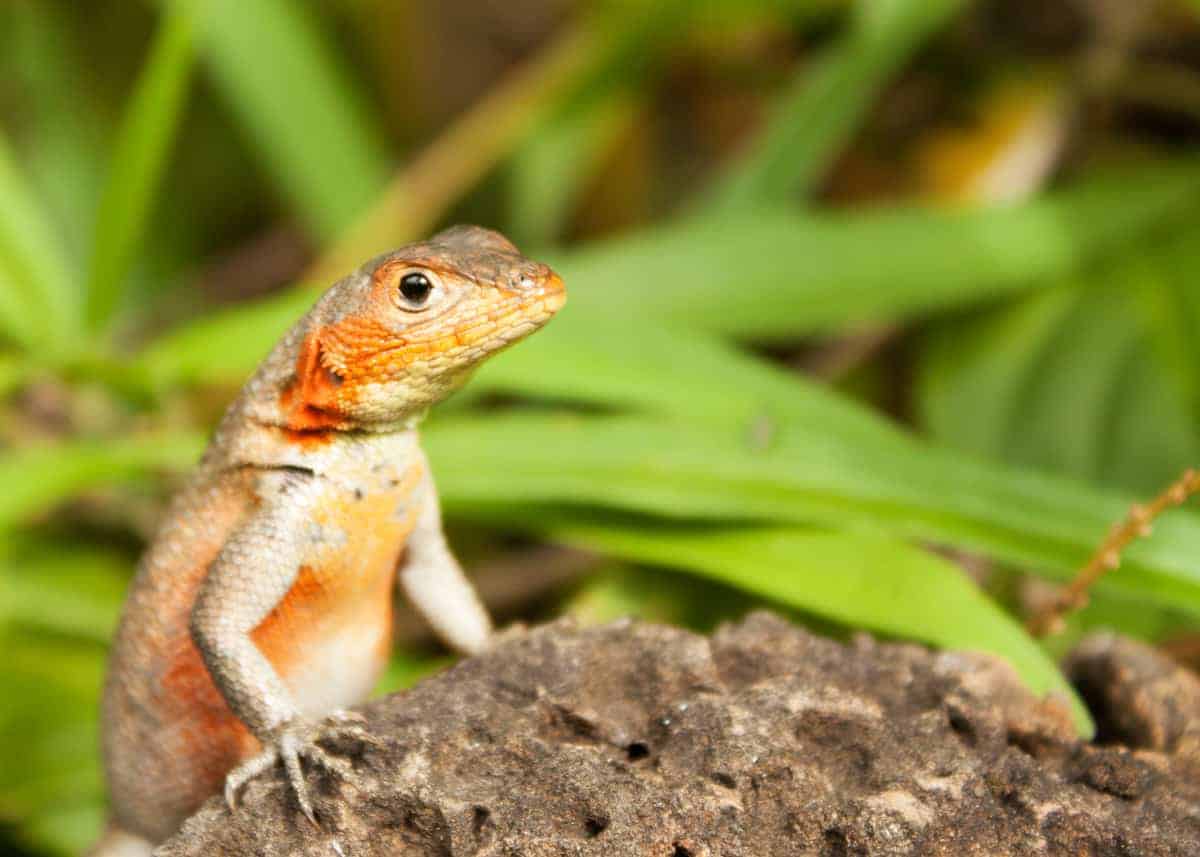
These spunky little reptiles are also known for their push-ups. Lava lizards bounce up and down to attract a mate, or in an effort to look big and scary when threatened – even though they’re not much bigger than your cell phone.
Males are up to 8 in (20 cm) long and females up to 7 in (18 cm). Unfortunately, the weight is unknown. Sufficient to say, they are pretty light.
Females lay up to 6 pea-sized eggs in the ground every month (roughly). Babies take anywhere from 3-12 months for the tiny (2 in; 5 cm) babies to hatch.
Lava lizards mainly eat different kinds of bugs, such as ants, beetles, and centipedes. They also help keep the painted locust under control on the islands.
Because of their buggy diet, lava lizards build their homes around flowers and cacti that naturally attract their favorite courses.
More reading: 7 Crazy Galapagos Lava Lizard Facts
Here’s why lizards do push-ups.
4. Giant Galapagos Tortoise (chelonoidis nigra)
These gentle giants may be one of the most popular animals to see in the Galapagos. Males grow up to 6 x 5 ft (1.8 x 1.5 m) and females are about half the size of males.
Galapagos tortoises live for a long time, generally over 100 years, and the oldest known case lived to 170.
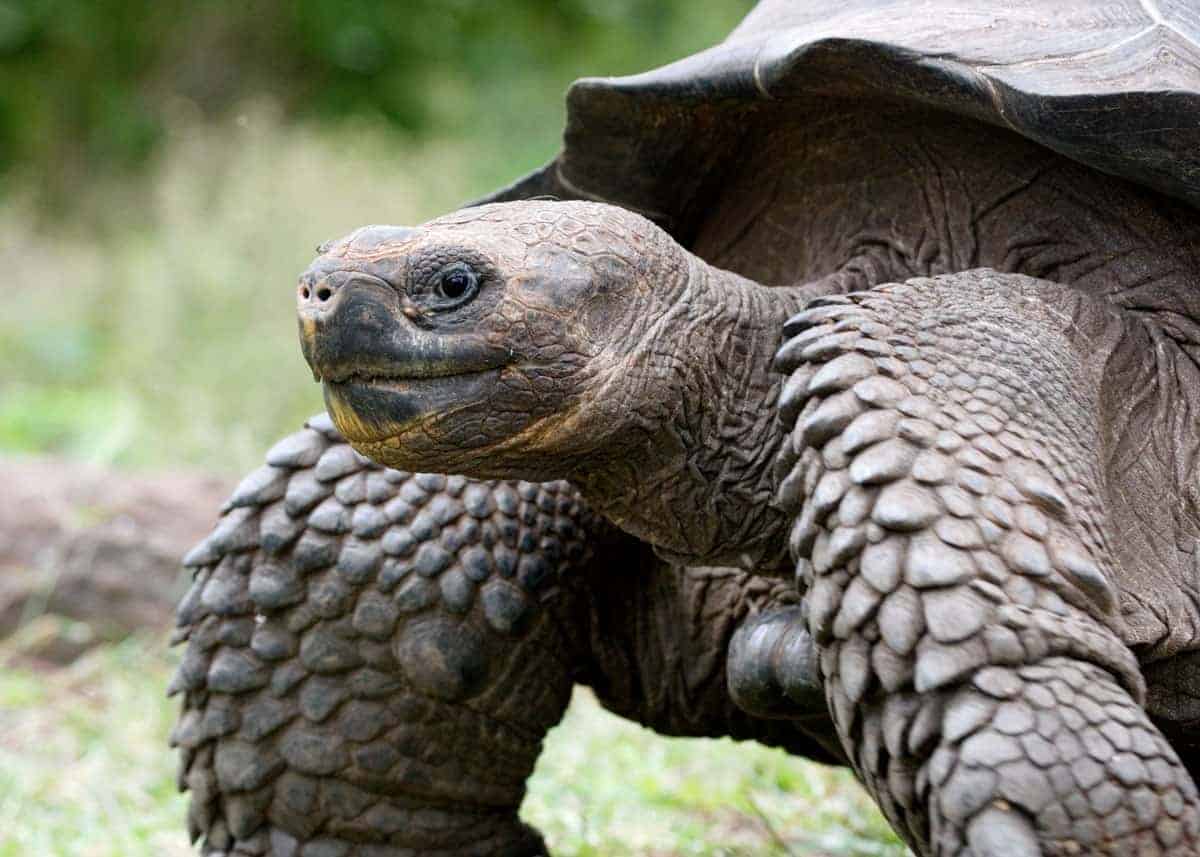
The tortoises kind of named the islands because the original explorers used the old Spanish word galapago to mean “saddle,” because the tortoiseshell was shaped like a saddle.
Unlike all the cartoon movies we watched as kids, tortoises can’t just jump out of their shells whenever they want. Their shell is actually part of their skeleton. Another fascinating thing about Galapagos tortoises is that they can go for a year without water or food!
5. Marine Iguana (amblyrhynchus cristatus)
Marine iguanas are endemic to the Galapagos and are the only iguanas that swim and feed in the ocean.
They don’t seem to enjoy all the salt they suck up while feeding on algae though, because they spend a fair about of time just laying around sneezing out the excess salt.
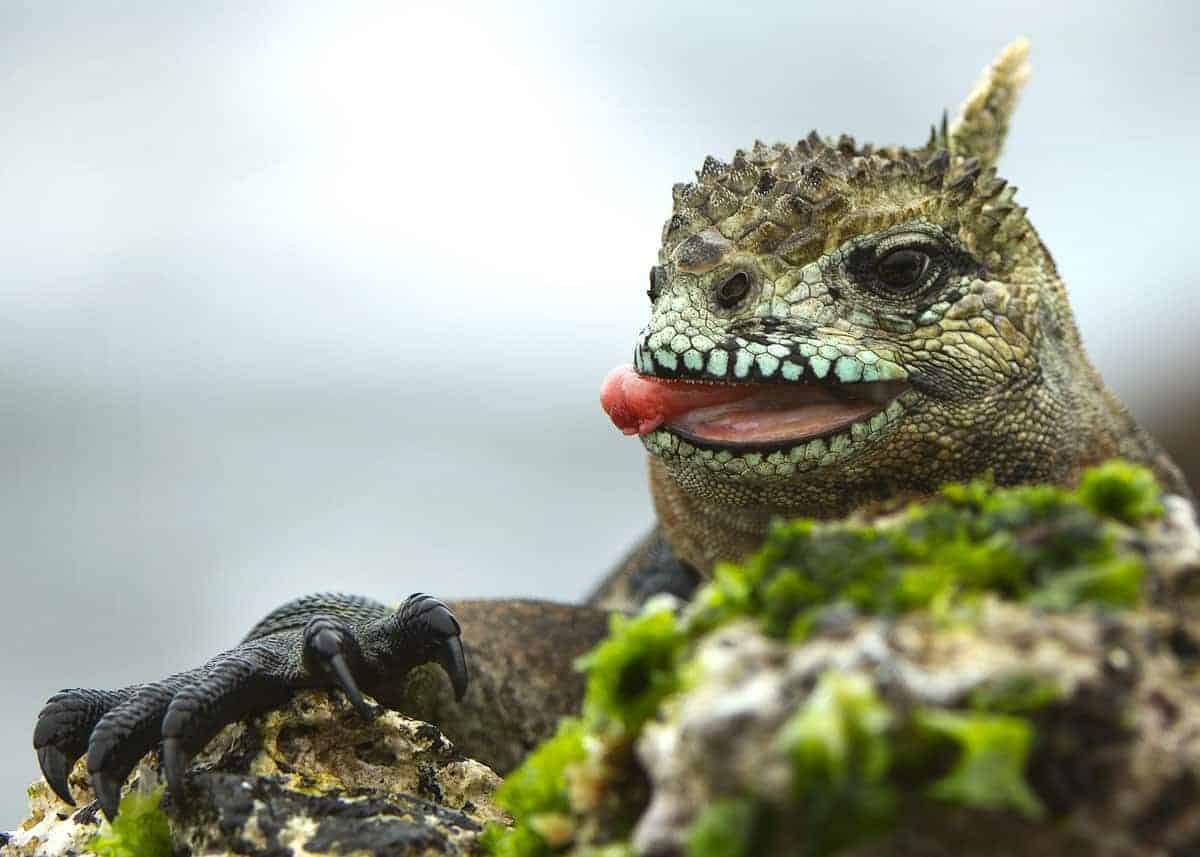
Marine iguanas can’t breathe underwater, but they can hold their breath for over 40 minutes and dive to around 30 ft (9.1 m). They can grow up to 3.2 ft (0.9 m) long and weigh up to 3 lbs (1.5 kg).
Most postcards will show you rainbow-colored marine iguanas. This happens to males during mating season to attract females.
6. Blue-footed Booby (sula nebouxii)
The blue-footed booby is definitely one of the Galapagos’ most popular animals. They love to entertain tourists with their funny dance and their brilliant blue feet.
Blue-footed boobies can be found along the Pacific coast, all the way from California to Peru, but the Galapagos is an amazing place to see these funny birds because half of all blue-footed boobies nest in the islands.
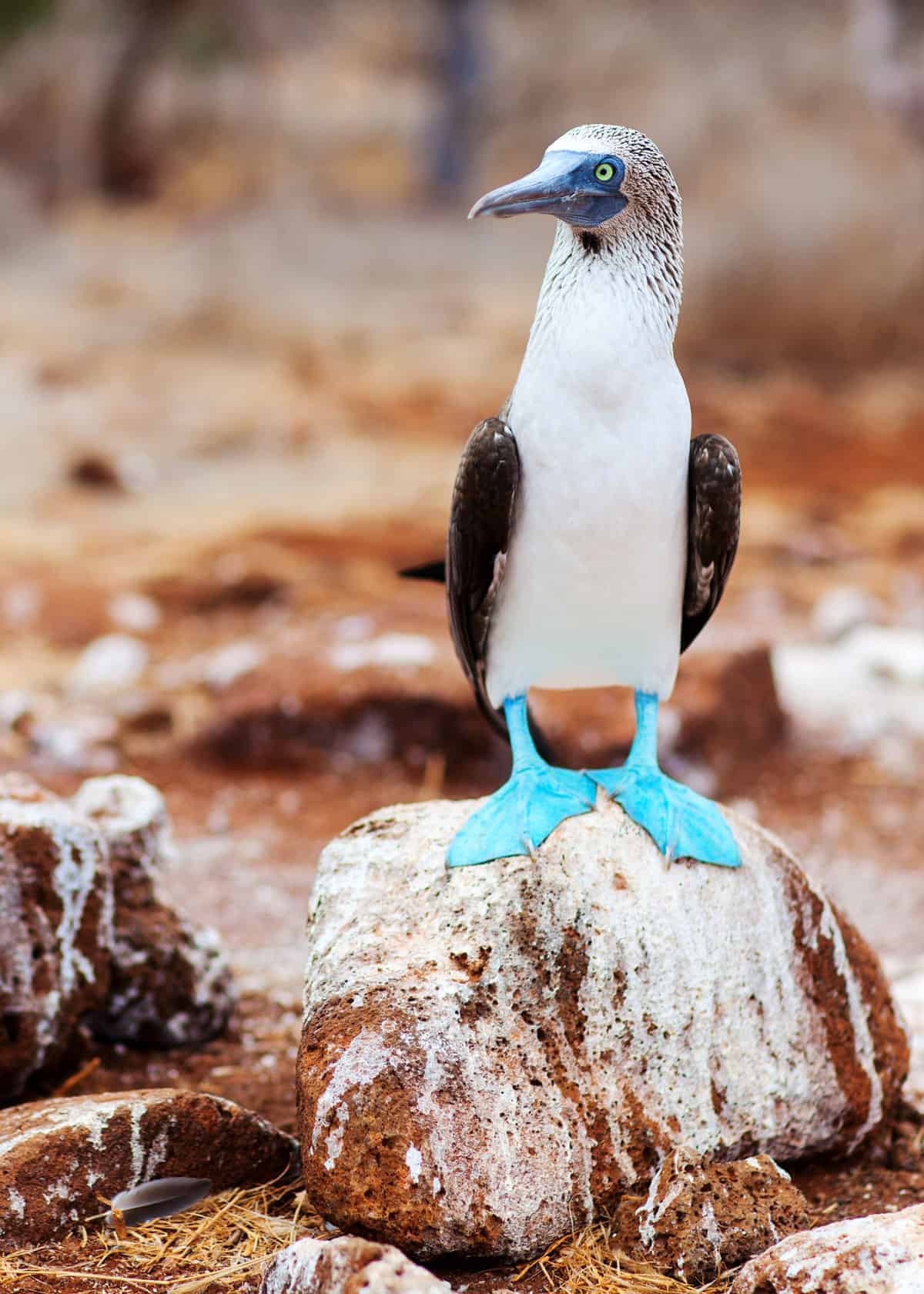
Their strikingly blue feet come from their fishy meals, and you can tell how healthy a blue-footed booby is by the blueness of its feet. Bluer is better!
Females will choose a male that has the bluest feet around because they know that they are healthy and will produce the best offspring.
Boobies have a very entertaining mating dance, as you can see in the video below.
Blue-footed boobies fish by flying up high in the air and then dropping like an arrow into the water.
Males hunt in shallow water because their small size and large tail make it easier for them to change direction once in the water. The females will hunt farther out because they are larger and can carry more fish.
It is amazing to watch boobies dive into the water! Enjoy the video, it’s fascinating!!
Blue-footed boobies have a wingspan of about 5 ft (1.5 m) and they are 32 in (81 cm) tall. They weigh about 3.3 lb (1.5 kg). The male is a bit smaller with a soft whistle and the female is larger and has a rather funny honk.
More reading: 43 Blue-footed Booby Facts
7. Red-footed Booby (Sula sula)
Just when you thought the blue feet were really something, the Galapagos gives you red feet.
The red-footed booby has a wider range than its blue-footed cousin. It is famous for its bright red feet and very colorful face and beak.
Red-footed boobies come in three color morphs and three subspecies. The Galapagos Islands are home to the world’s largest nesting colony of these curious birds.
Learn more about them in our guide to red-footed boobies.
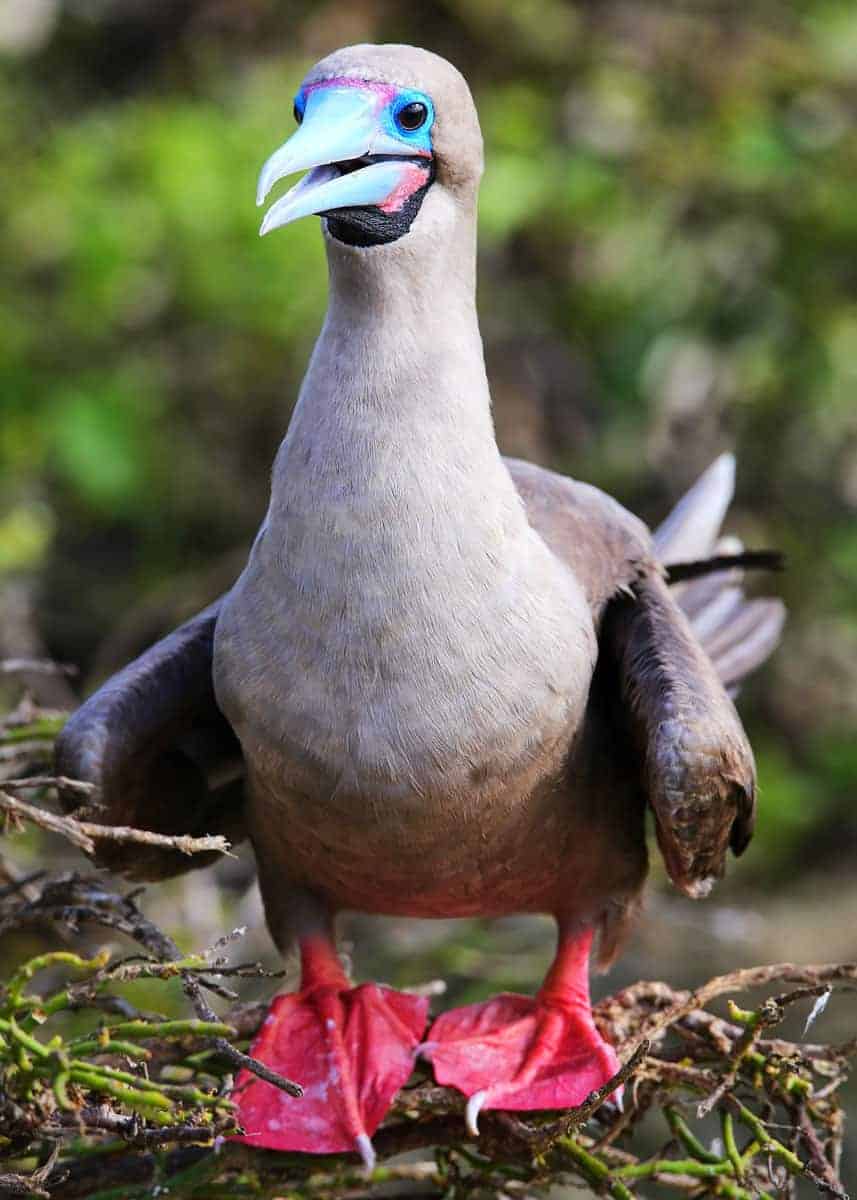
8. Vermilion Flycatcher (pyrocephalus rubinus)
Vermilion flycatchers are pint-sized fiery balls of spunk. These little guys are easy to spot: bright red with black wings and a black mask, however, the vermilion flycatcher bright colors fade in captivity.
They can be found in Central and South America, as well as Mexico and the United States. The females lay up to 4 eggs – which hatch in about 2 weeks, after which both parents share in caring for the babies.
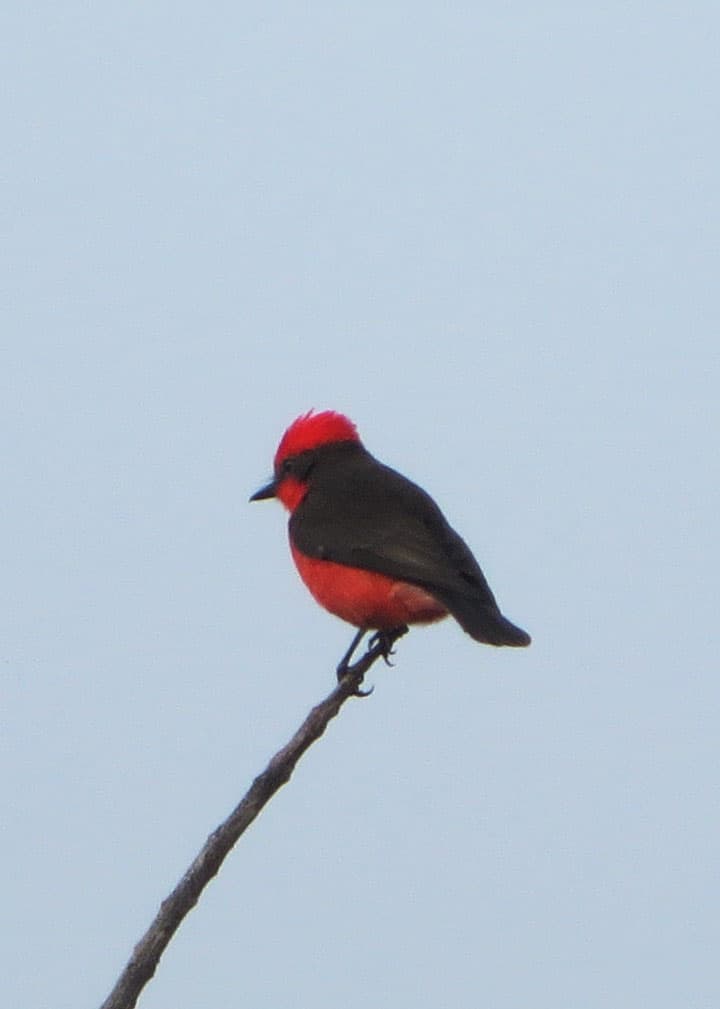
More reading: 15 Facts About Ecuador’s Vermilion Flycatcher
9. Swallow-tailed Gull (creagrus furcatus)
These sweet-looking gulls are the only nocturnal member of their family. They lay only one egg at a time, and they never leave their young unattended.
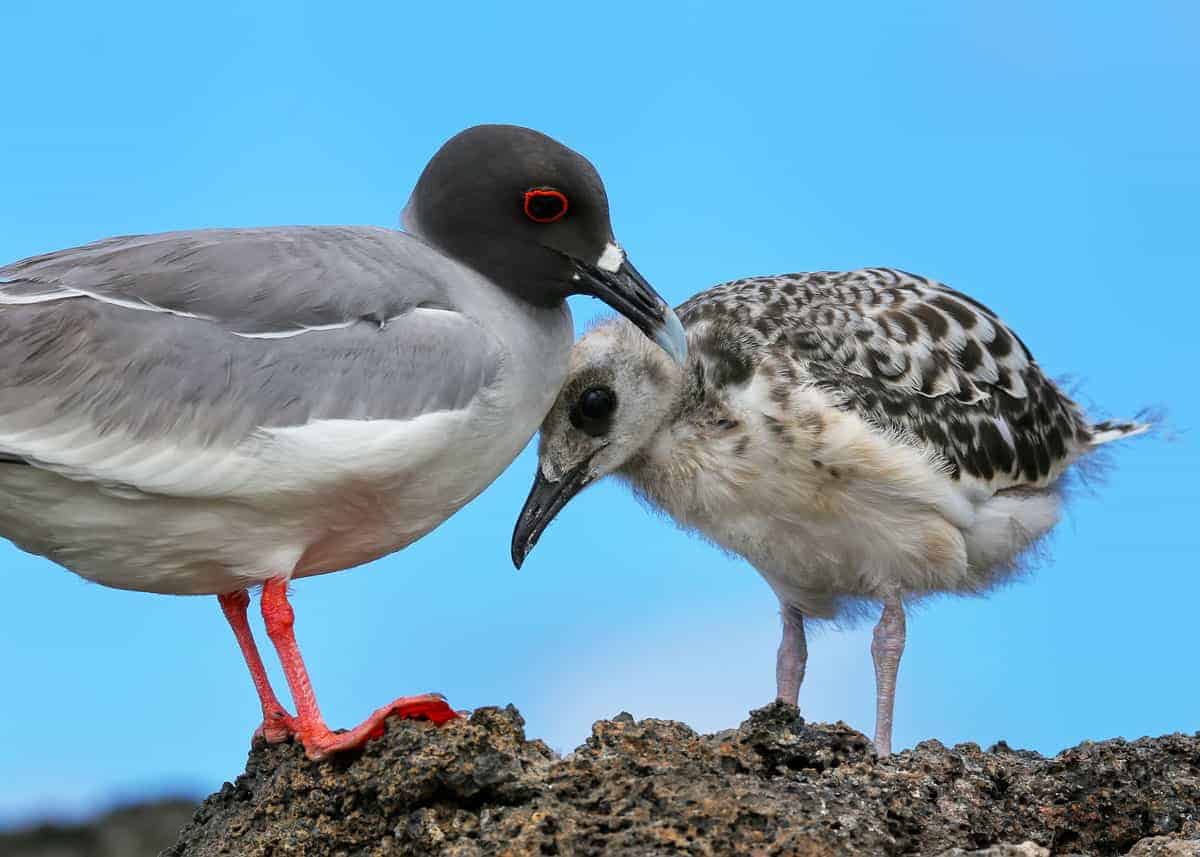
Amazing fact: the red ring around the swallow-tailed gull’s eye does more than make a statement. It actually gives these birds a type of night vision! It secretes an orange/red oil that acts as a light filter to enhance their prey’s (squid) light coloring.
Learn more about the swallow-tailed gull in our huge post.
10. Nazca booby (sula granti)
These are the largest boobies in the Galapagos, measuring 3 ft (0.9 m) long and a 6 ft (1.8) wingspan. You can tell male and female Nazca boobies apart by their unique calls – the males whistle and the females honk.
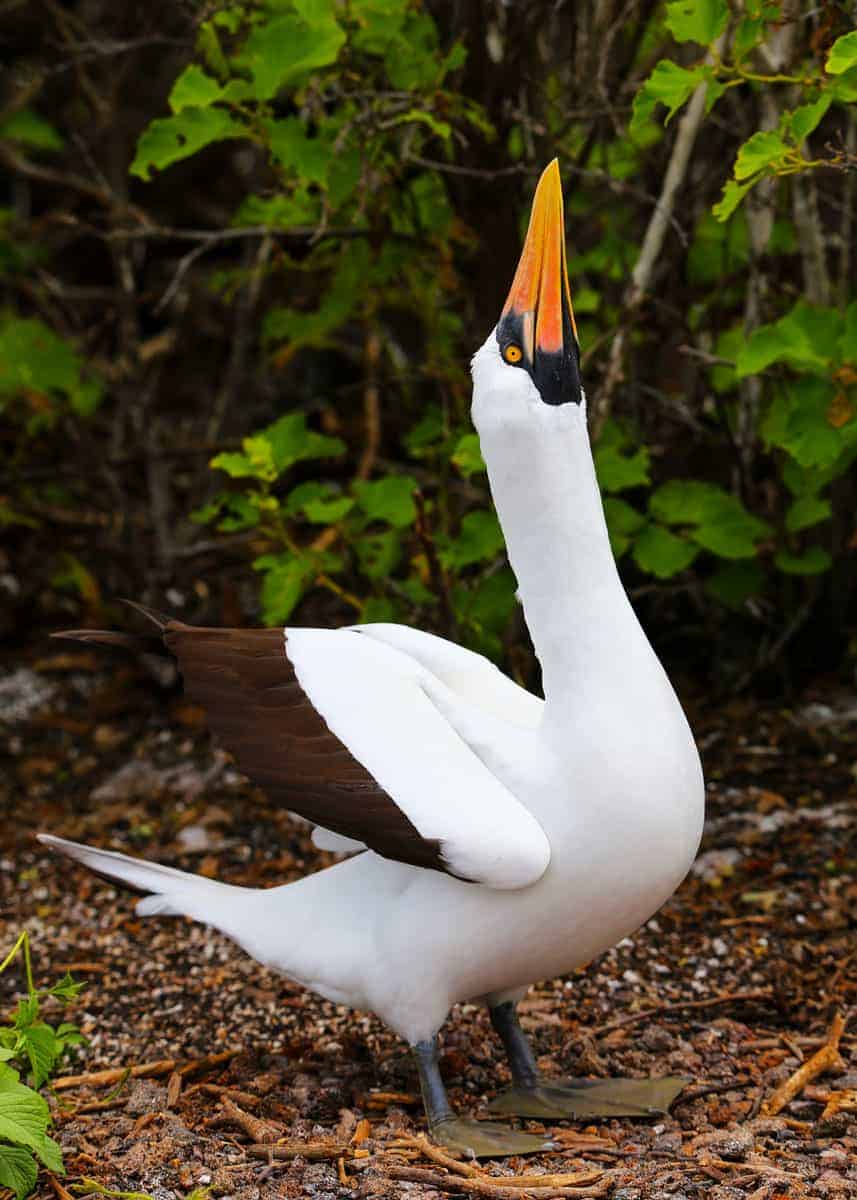
Another interesting thing about these birds is that their mating season is different on each island.
Learn more about Nazca boobies in our huge post.
11. Galapagos penguin (spheniscus mendiculus)
Yes, there are penguins in the Galapagos. In fact, they are endemic to the islands and the only penguins that live north of the equator!
These are also one of the smallest penguins in the world, weighing only 5.5 lb (2.5 kg) and being 19 in (49 cm) tall! Galapagos penguins mate for life and share in caring for the 2 eggs.
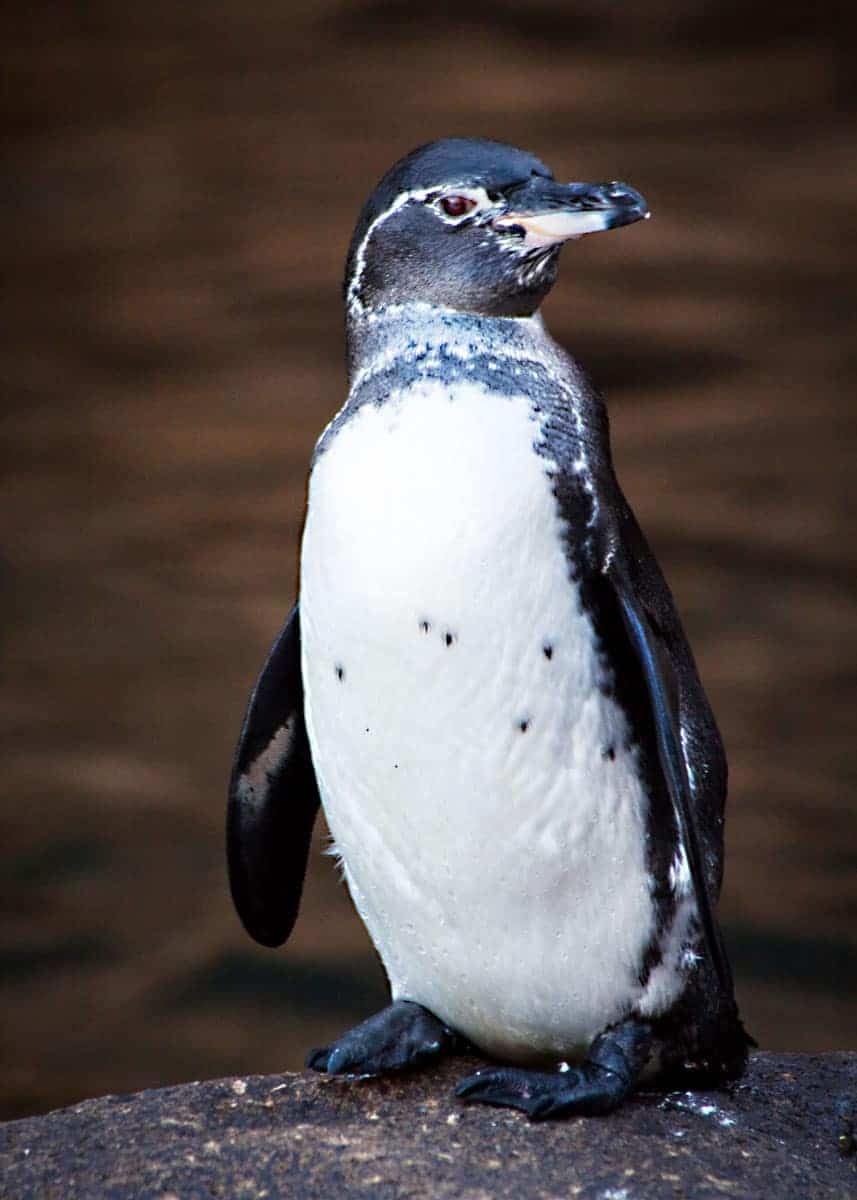
12. Lava heron (butorides sundevalli)
The lava heron is endemic and lives on all the Galapagos Islands all year round. However, you may not see them because they blend into the lava very well.
Lava herons are amazing hunters, feeding on small crabs, fish, prawns, lizards, small birds, and eggs.
During the mating season, the male lava heron’s beak turns black (instead of its normal grey) and his feet turn bright orange (also in stark contrast to their usual grey color).
Lava herons mate once per season and raise the young together. Like many other animals in the Galapagos, they don’t mind people.
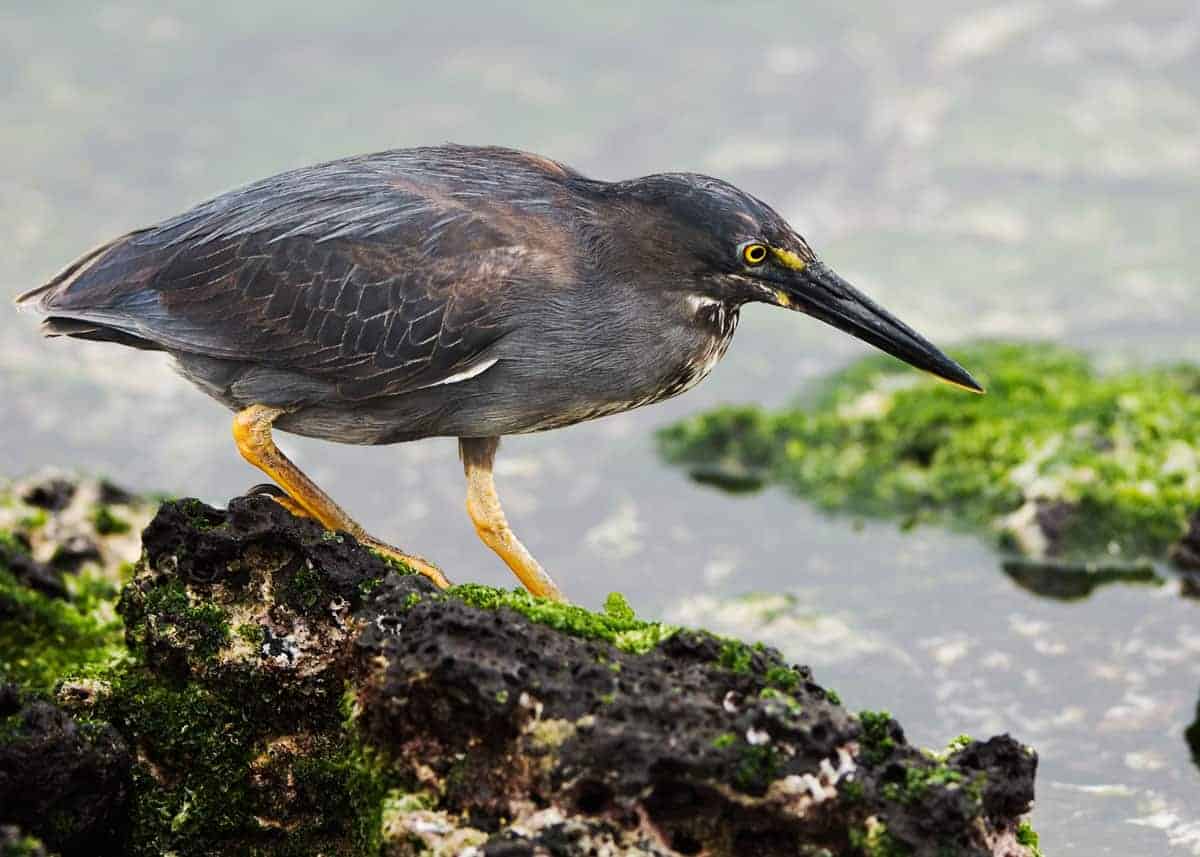
13. Galapagos fur seal (arctocephalu galapagoensis)
Many people confuse the Galapagos sea lion and the Galapagos fur seal, but once you know what to look for, they are easily distinguished.
Here’s what to look for:
- The Galapagos fur seal has a short snout, but sea lions have a longer snout
- Fur seals, as the name would suggest, have a very thick coat
- Sea lions prefer to lay in the sun, whereas fur seals prefer the shade
- Most Galapagos fur seals live on Fernandina and Isabela islands, but the sea lions are more widely distributed
- Fur seals are also much smaller than sea lions
- Fur seal’s ears stick out much farther than sea lions
14. Galapagos hawk (buteo galapagoensis)
The Galapagos hawk is endemic to the islands and has no natural predator. It feeds mostly on rats, marine and land iguanas, locusts, lizards, baby tortoises, and baby sea turtles, and centipedes.
These hawks return to the same nest every year and are able to live anywhere on the islands (lava fields, forest, mountains, beach…).
Young hawks are lighter in color than the adults and have yellow-green feet and legs as well as greyish base on their beaks. The males are slightly smaller than females, the Hawks can have a wingspan of up to 4 ft (120 cm).
Learn more in our huge guide to Galapagos hawks.
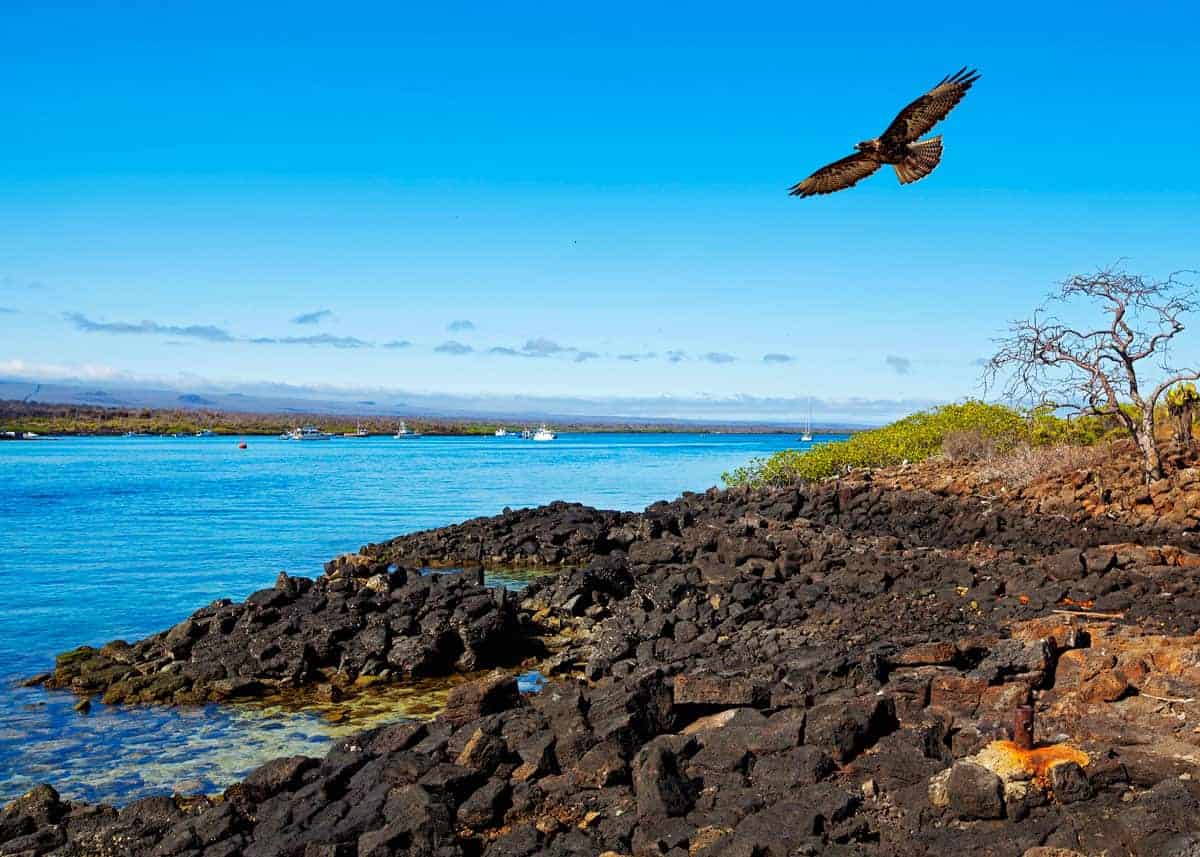
15. Galapagos sea turtle (chelonia agassizii)
Galapagos sea turtles are smaller, darker, and have a more domed shell than other Pacific sea turtles.
Fun Fact: The Galapagos sea turtle has this name because the Galapagos is the only place it will lay its eggs. Once every 2-3 years (between January and March), a female will swim onto the beach at night and dig a hole in the sand, where she will lay up to 200 eggs!
The temperature of the sand can determine whether there will be mostly male or female babies. Warm (over 85°F/30°C) for females and cool (under 85°F/30°C) for males.
Did you know? There are four species of sea turtles in the Galapagos.
16. Galapagos noddy tern (anous stolidus galapagensis)
Galapagos noddy terns are seabirds – that can’t dive into the ocean. Instead, they will fly low over the surface and scoop up fish.
Or, if they are brave, they sit on the heads of pelicans and catch fish that escape or they pester the pelican until it gives up its catch.
The Galapagos noddies are the largest of their kind, having a wingspan of up to 86 cm (34 in). Because of their inability to plunge into water, their wings are specially designed to help them glide for long distances over the surface of the water.
17. Galapagos shark (carcharhinus galapagensis)
Galapagos sharks are calm, curious, and persistent little sharks. They rarely attack humans; in fact, they are considered some of the safest sharks in the world!
But they are still sharks and still dangerous. So don’t poke them with sticks or call them names. Calamity will ensue.
Galapagos shark gives birth to live young, however, they do not care for the pups after birth. They can smell things, such as blood, up to one part per million (that means one drop of blood to one million drops of water!).
They hang out in groups around the islands, so don’t fall in with a scraped knee… kidding! But it’s probably not a good idea.
18. Great & Magnificent Frigate Birds (Fregata minor & Fregata magnificens)
These birds are famously known for that big red gular sac (commonly known as “that big red balloon thing”) that they blow up on their chest to attract a mate. It takes the male 20 minutes to inflate his sac!
Like the noddy tern, frigate birds are kleptoparasitic (steals stuff from other birds) seabirds that would rather not land in the sea. The frigate bird’s name comes from the old warships from the 17th-19th centuries, fast, maneuverable, and strong – the name certainly suits the birds as well as the ships.
More reading: Great Frigatebird vs Magnificent Frigatebird: 14 Frigatebird Facts
19. Waved Albatross or Galapagos Albatross (Phoebastria irrorata)
The largest bird in the Galapagos is the waved albatross. It can have a wingspan of over 8 feet!
Waved albatross are famous for their mating dance. And for mating for life.
Learn more in our guide to waved albatross.
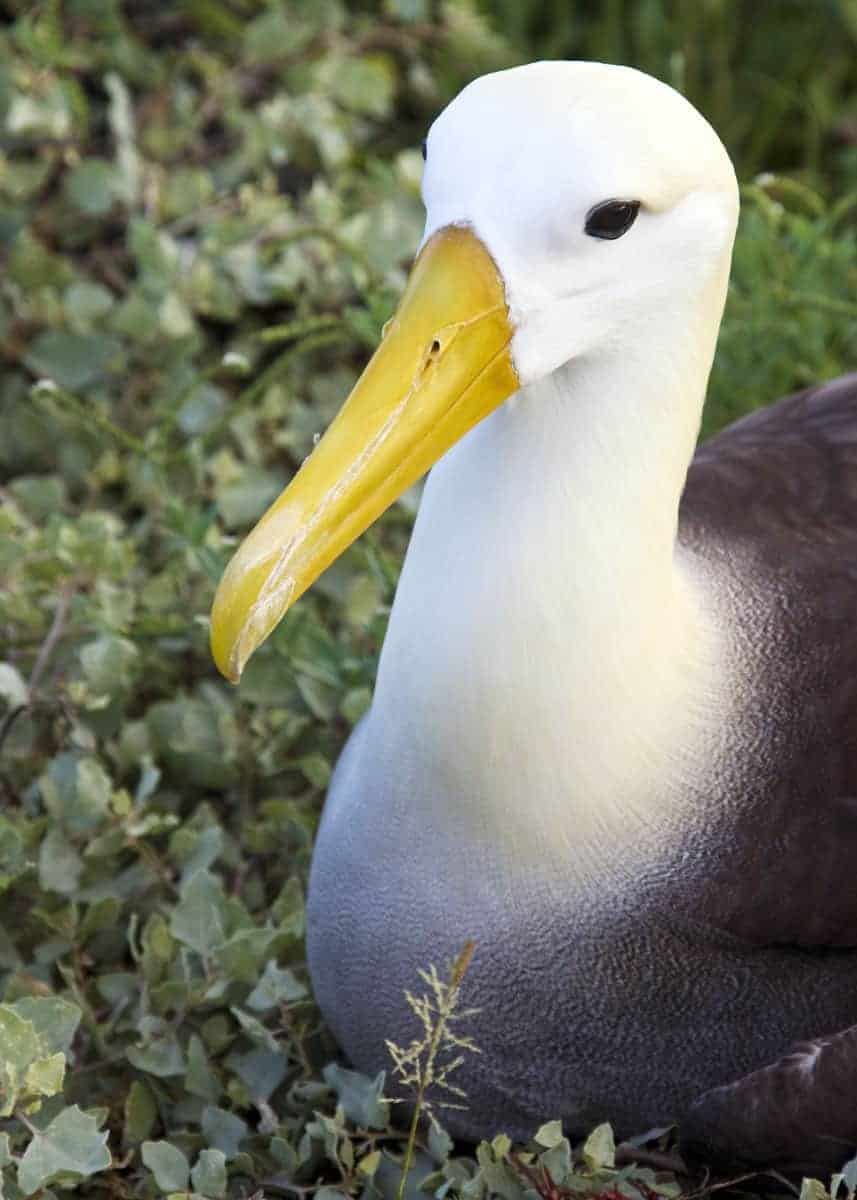
Learn more with these 25 Galapagos Islands Facts.
Animals on Islands of Fire
That’s it for my 19 Galapagos animals to see on your next trip, I hope you enjoyed it. We will be updating this post with new animals and new facts, so check back!
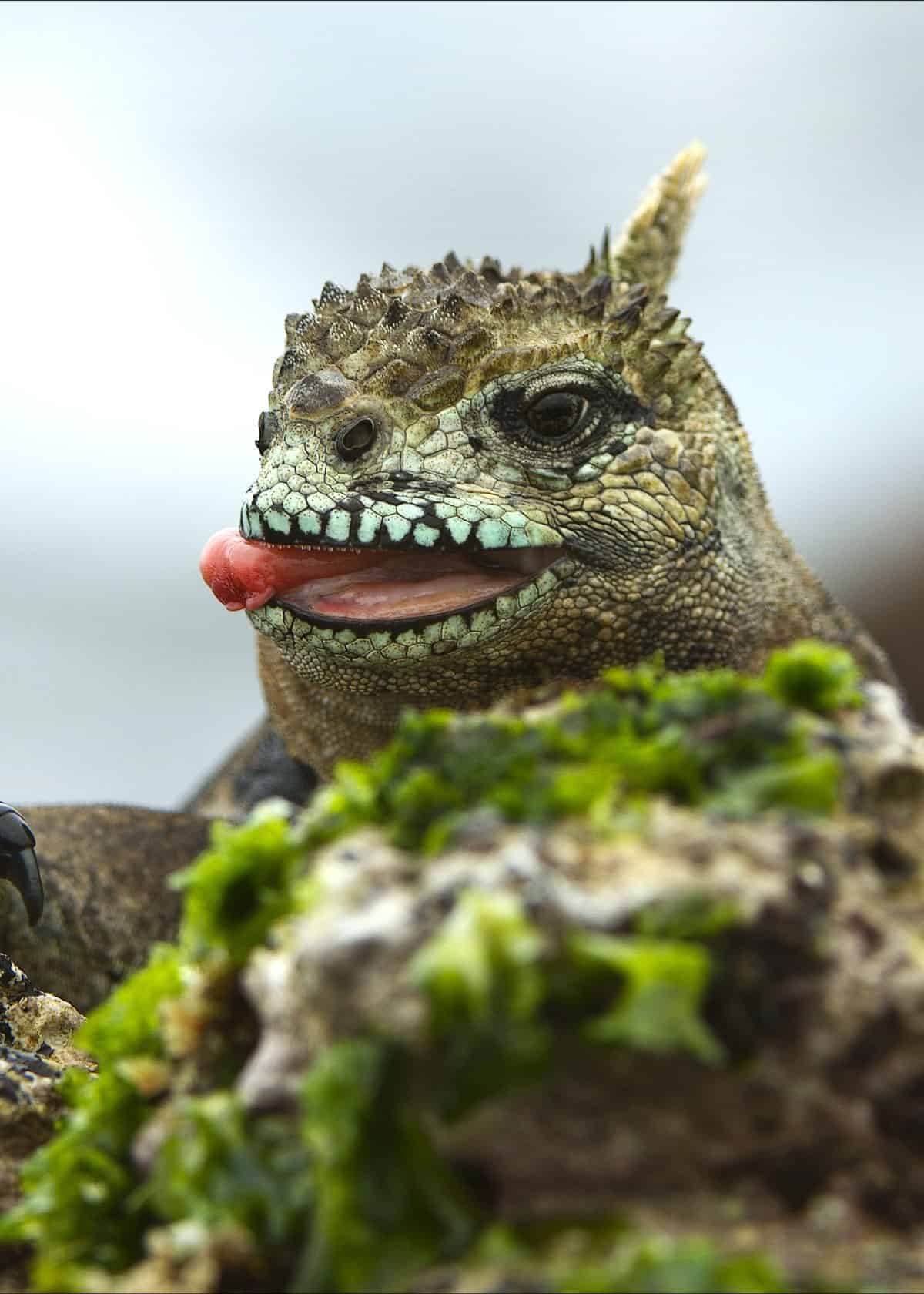
Curious about other parts of Ecuador? Check out our guide to Amazon Rainforest Animals.
Do you have any animals to add to this list? What’s your favorite? Any Galapagos stories we should know? Let us know in the comments!
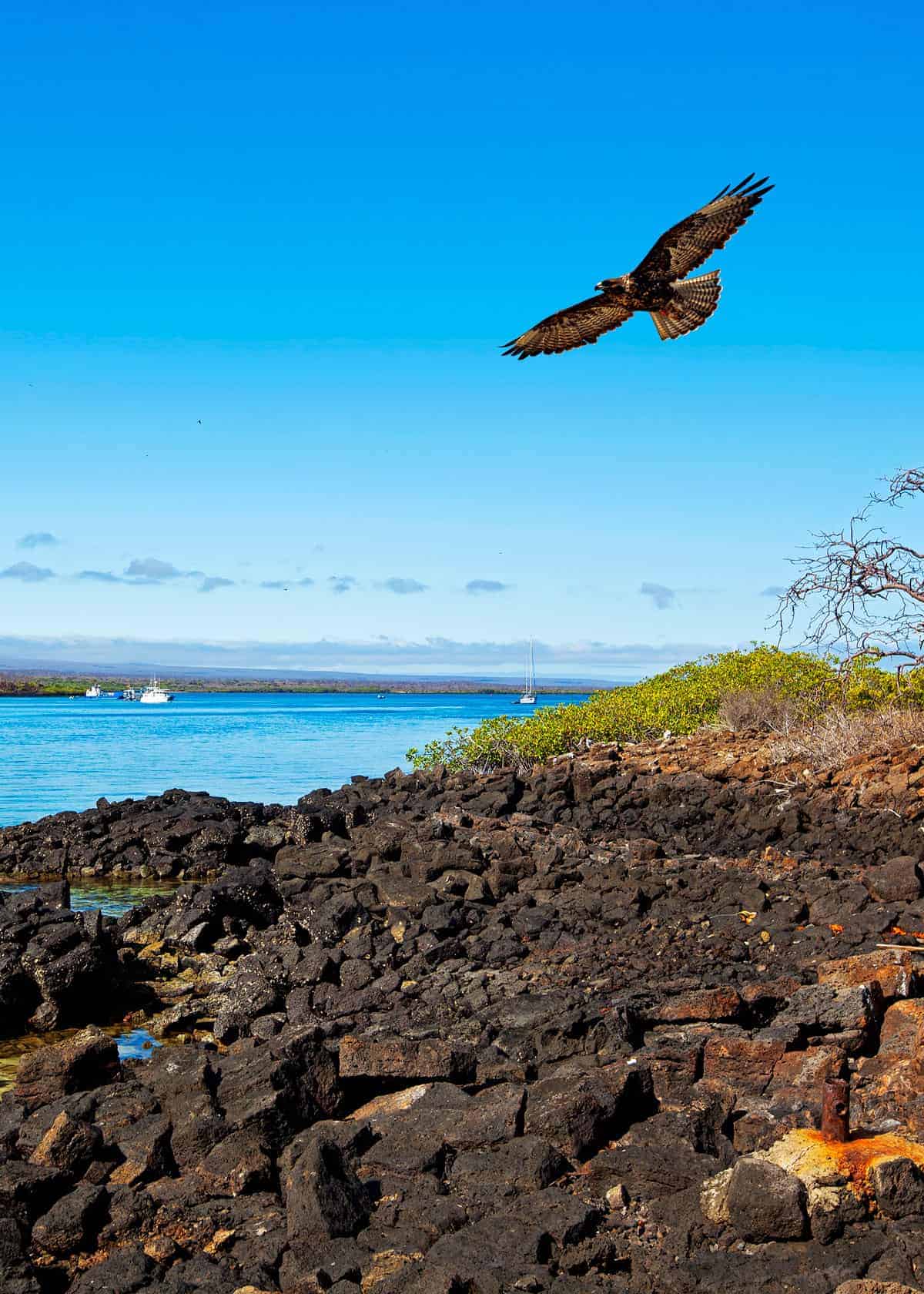
Galapagos Animals: Up-Close and Curious
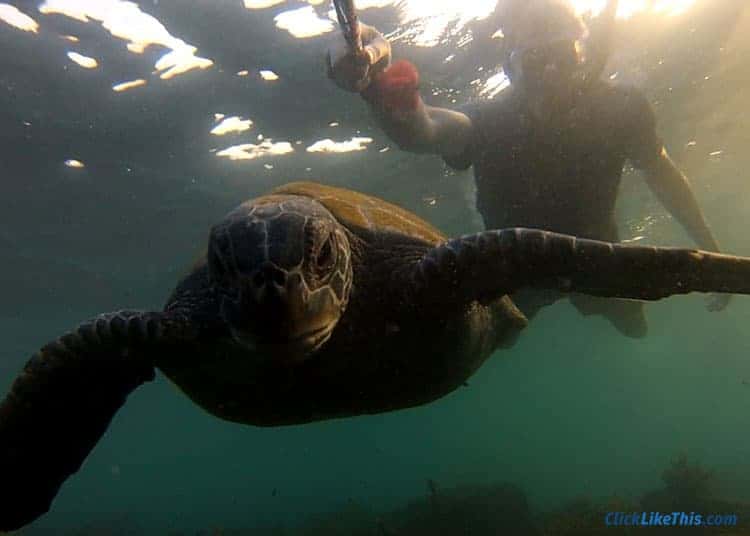
Galapagos animals are different than any we’ve seen.
Of course, some of them are huge and others have blue feet. But it’s more than that. They are bold and unafraid. Because the Galapagos Islands are protected, and the majority of them are part of the National Park, the animals don’t fear us.
In this video, we share some of our favorite animal encounters: sea turtles, giant tortoises, sea lions, marine iguanas, lava lizards, pelicans, and more. Each animal comes over to our camera to check it out.
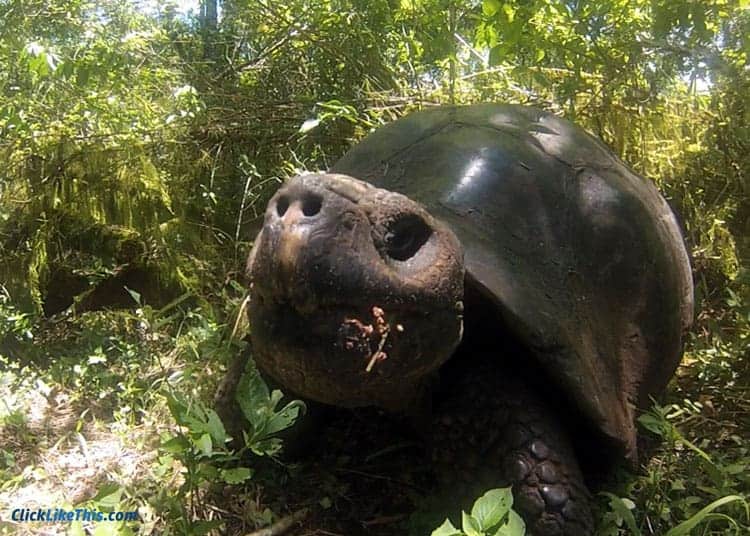

Planning a trip to the Galapagos? Our favorite island was Floreana. It has a pretty bizarre history.
Your Turn
What’s your favorite Galapagos animal? Are you planning on visiting the Islands? Please share it below!






